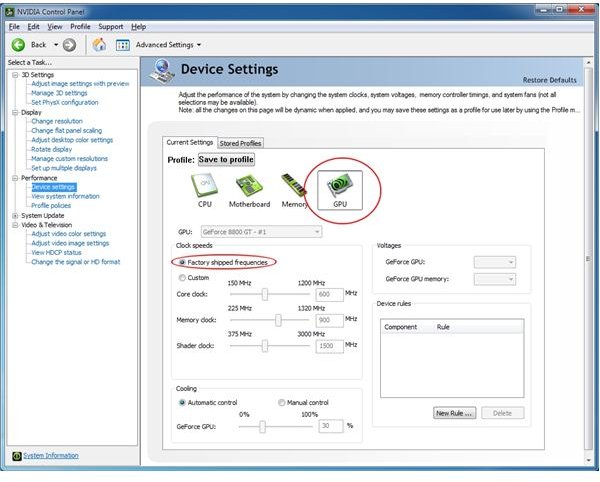How to Use the nVidia Overclocking Utility to Overclock your Video Card
The advancement of computer graphics has progressed so far that we can now overclock our video cards easily and safely using nothing but software right from within Windows. However, before you attempt to overclock your video card there are a few things you should understand.
What is Overclocking?
Overclocking is nothing more than running a computer component such as a CPU, RAM, motherboard, or video card at a higher rate than the original manufacturer intended. A higher rate means that the component will achieve more clocks per second than its original configuration allowed.
Many gamers attempt to squeeze more performance from their video cards by overclocking the core, memory, and shader components of a graphics card. There is some danger of damaging the component if you attempt to overclock your video card too far. Therefore, steady increases at a time until failure are recommended to avoid damaging expensive computer components.
Use the nVidia System Tools Utility to Overclock
If you own an nVidia video card, the manufacturer created a special program to help you overclock your graphics card right from within Windows. Rather than having to enter changes in your computer’s BIOS, nVidia makes it as easy as changing some key values using a few sliders to overclock your video card.
To begin, download nVidia’s free System Tool utility and install the application. The download is only about 91MB so it is a quick download.
Once you have installed the utility, click on Start>All Programs>NVIDIA Corporation>NVIDIA Control Panel>Performance. This opens the performance section of the nVidia Control Panel. Expand the Performance section in the task pane on the left and click on Device Settings.
You’ll notice that you have the choice to overclock up to four major components depending on the hardware in your computer. The four components are CPU, motherboard, memory, and GPU. The GPU stands for Graphics Processing Unit and represents your computer’s video card. Click on GPU to begin overclocking your graphics card.
Depending on the hardware you have in your computer, you have several options here. Notice that the option Factory Shipped Frequencies is selected by default. If at any time you wish to return your frequencies to factory default, choose this option and everything will be back to normal.
Clicking the Custom option allows you to specify the core, memory, and shader clock individually. Each of these components is responsible for a different aspect of your video card’s performance.
Core Clock. The core clock is like the CPU of the video card. The video card’s core processor is responsible for all of the calculations needed to push graphics out to your monitor. Not surprisingly, the faster the core processor is allowed to operate, the more information it can process before it sends it to your monitor.
Memory Clock. Don’t confuse your graphics card’s memory with your computer’s memory here. The memory clock refers to the RAM on your video card only. Faster video memory means faster access times and less time spent storing and retrieving data.
Shader Clock. Unlike ATI video cards, nVidia allows you to specify separate frequencies for the core and shader clocks. Shaders are used by 3-D games in particular to deliver graphics that are more realistic by controlling how fast calculations are made. This is one you setting you will have to play with to get the right combination of core vs. shader clock frequencies.
Conclusion
Overclocking your nVidia video card with the free System Tools utility is a simple matter of sliding a few bars to change the clock frequencies of three major components. However, don’t let the ease with which the frequencies can be changed cloud your understanding that overclocking a video card can damage it. Take it slow and proceed a little at a time. With the right combination of frequencies, you can significantly increase your graphics card’s capabilities beyond what the manufacturer intended.
